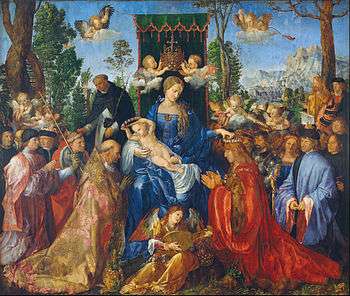Feast of the Rosary
 | |
| Artist | Albrecht Dürer |
|---|---|
| Year | 1506 |
| Medium | Oil on panel |
| Dimensions | 162 cm × 194.5 cm (64 in × 76.6 in) |
| Location | National Gallery, Prague |
The Feast of the Rosary (German: Rosenkranzfest) is a 1506 oil painting by Albrecht Dürer, now in the National Gallery, Prague, Czech Republic.
History
The work dates to Dürer's sojourn in Venice, and had been commissioned by Jakob Fugger, intermediary between emperor Maximilian I and Pope Julius II, during the painter's stay as the banker's guest in Augsburg.[1]
The contract was renewed in the Italian city by the brotherhoods of the traders from Nuremberg (Dürer's hometown) and from other German cities, the latter being supported by the Fugger family.[2] According to the contract, the painting, to be housed in the church of the German nation in Venice, San Bartolomeo at Rialto, should be finished before May 1506.[1] The subject was the Feast of the Rosary, a theme connected to the particular worship that the German citizens in Venice had towards Our Lady of the Rosary.[3]

The execution however dragged on until September of that year, when the Doge, the Patriarch and other Venetian nobles visited Dürer's workshop to see the finished work. In a later letter written to Nurnberg's Senate in 1523, Dürer wrote how, in that occasion, the doge had proposed him the position of the Republic's painter, but he had refused.[4] The visitors included perhaps, among other artists, Giovanni Bellini.[4]
The work was acquired by emperor Rudolf II in 1606, who had it moved to Prague.[2] It was assigned to the Strahov Monastery and, during the centuries, it underwent to several restorations, causing damage to the painted surface. Later it was moved to the Rudolfinum and then to the National Gallery of the Czech capital.[4]
Description
The painting shows the Virgin Enthroned holding the Child in the center, with two flying angels who are holding, above her, an elaborated royal crown made of gold, pearls and gems; this was a Flemish art scheme already widespread in the German area at the time. The throne's backrest is covered with a green drape and by a baldachin which is also held by two flying cherubim. Below is an angel playing a lute, an evident homage to Giovanni Bellini's altarpieces. Mary is depicted in the act of distributing rose garlands to two groups of kneeling worshippers, portrayed on two symmetrical rows at the sides.[5]
The two rows are headed, on the left, by Pope Julius II (who had been approved the German brotherhood with a bull in 1474), crowned by the Child and followed by a procession of religious figures; and, on the right, by the German emperor Frederick III (portrayed with the face of his son and patron of Dürer, Maximilian I), crowned by Mary and followed by a lay procession. Dürer likely based his portrait of the emperor on a drawing by Ambrogio de Predis, who had worked for Maximilian at Innsbruck.[4] The pope and the emperor, considered at the time the supreme authorities of the Catholic world, have previously deposed the papal tiara and the imperial crown, and are now kneeling to receive the Madonna's blessing.[5]

Other angels are distributing crowns of flowers, as well as St. Dominic of Guzman (protector of the adoration of Mary and of the Rosary), who stands at the side of the Virgin. Near the left border is the patriarch of Venice, Antonio Soriano, with the hands joined, and, next to him, Burkard von Speyer, then chaplain of the church of San Bartolomeo, who was also portrayed by Dürer in another painting.
On the right, nearby a lush Alpine landscape, is the artist's self-portrait with a cartouche in a hand: here is the signature with a short inscription, reporting the time needed to complete the work (five months).[4] The characters next to the painter are likely Leonhard Vilt, founder of the Brotherhood of the Rosary in Venice, and (in black) Hieronymus of Augsburg, the architect of the new Fondaco dei Tedeschi. Annexed is the donor's portrait.
The style of the work is reminiscent of some Bellini's works featuring the same quiet monumental appearance, such as the San Giobbe Altarpiece (1487) or the San Zaccaria Altarpiece (1505),[4] especially regarding the guitar playing angel in the center. Most the work was subject to later repainting, including the great part of the heads and some half of the panel[2]
| Wikimedia Commons has media related to Rosenkranzfest by Dürer. |
References
Sources
- Costantino Porcu, ed. (2004). Dürer. Milan: Rizzoli.
